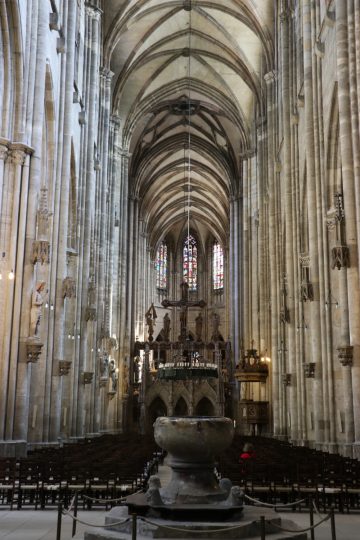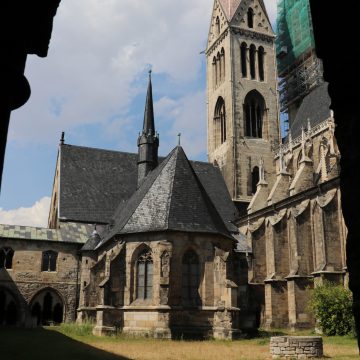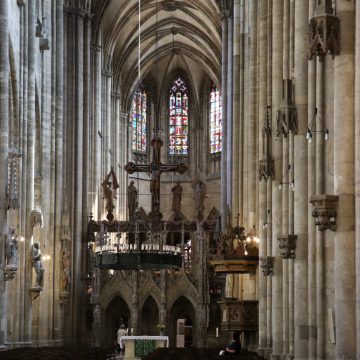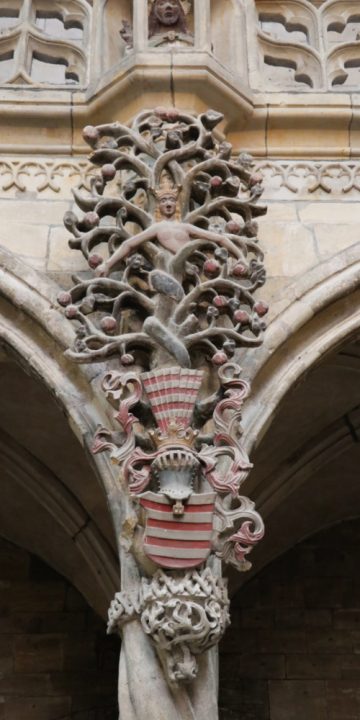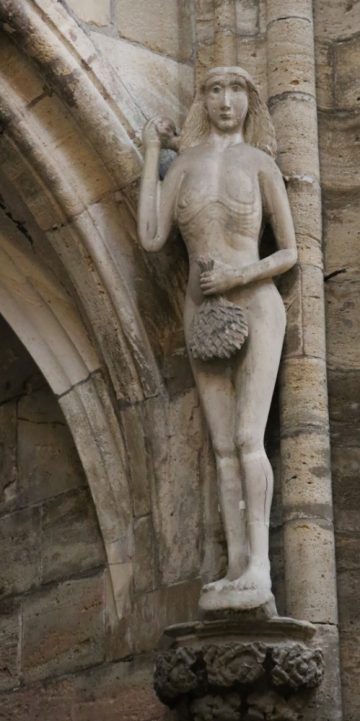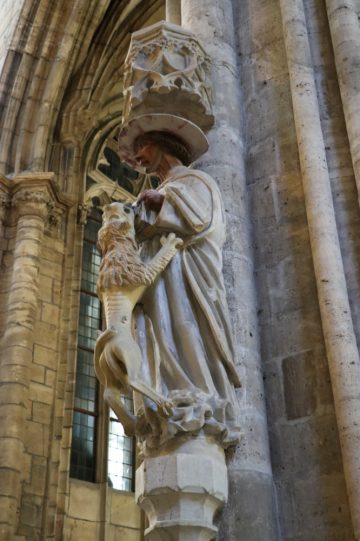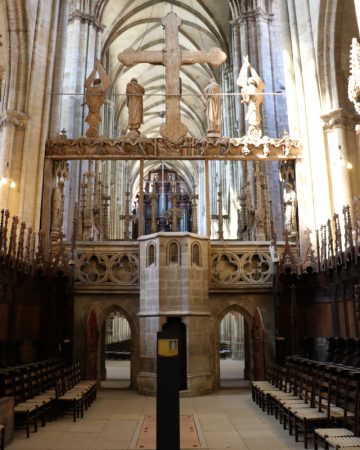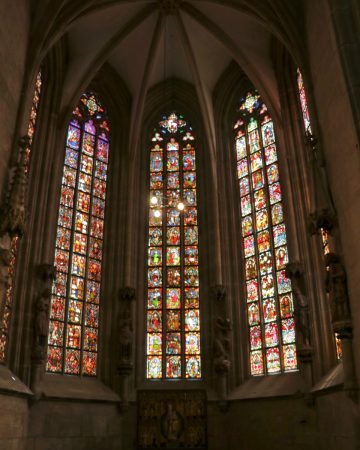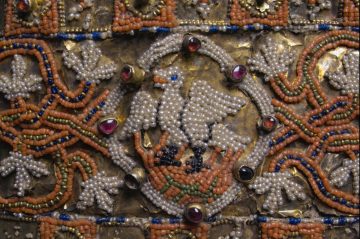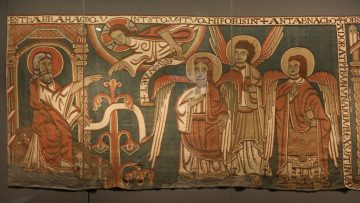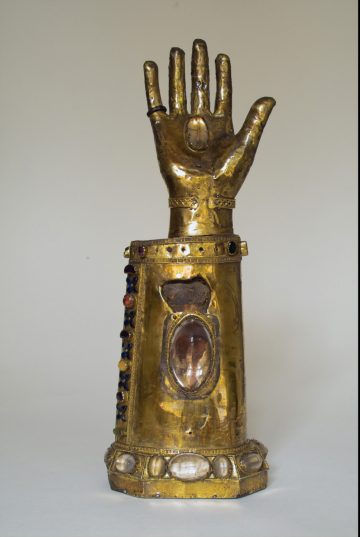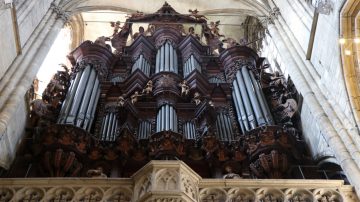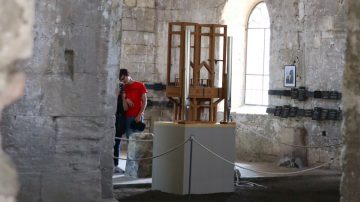Visit the gothic Dom zu Halberstadt in Saxony-Anhalt to see one of the best and most important medieval cathedral treasuries (Domschatz) in Germany.
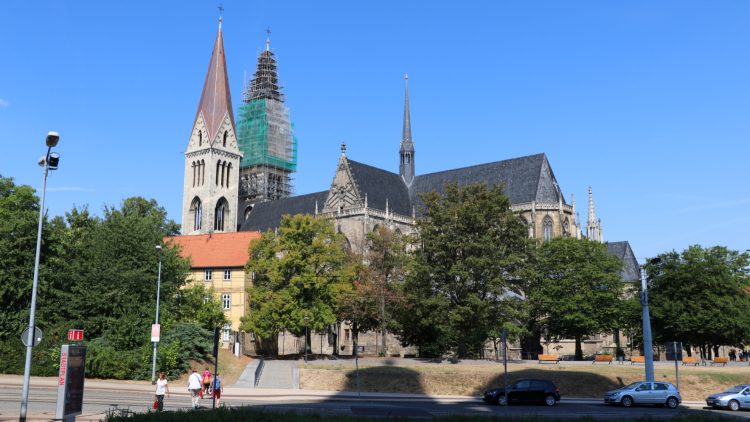
The Dom St. Stephanus und St. Sixtus (Cathedral of St Stephen and St Sixtus) in Halberstadt in Saxony-Anhalt is one of the finest French gothic churches in Germany. However, it is most famous for having one of the largest and most important cathedral treasuries in Germany. Around 300 items from this Domschatz are on permanent display, including the oldest picture tapestries in Europe.
Halberstadt Cathedral in Saxony-Anhalt
The Dom in Halberstadt has one of the longest histories of any church in the region to the north of the Harz Mountains in central northern Germany. The bishopric was founded by Charlemagne in 804 after he had subjected the pagan Saxons. In 992, the original Carolingian church was replaced by an Ottonian Romanesque basilica that was still in use during most of the building period of the current Gothic church (1236 to 1486).
The cathedral in Halberstadt largely resembles the medieval original — both the exterior appearance as well as the internal furnishings. It is a typical triple-nave basilica in the shape of a Latin cross with a protruding transept and a choir with an ambulatory. Some of the cloisters and other buildings used by the cathedral chapter survived and now houses part of the treasury.
The Halberstadt Cathedral followed the French Gothic style much closer than most other large churches in Germany. The interior is airy because the original pillars were dangerously slender — metal supports were essential in the 20th century to prevent their total collapse. As in many French churches, the side naves lead seamlessly into the ambulatory around the high choir.
The height of the nave is 27 m while the side naves raise 14 m. The interior of the church is 102 m. The towers are 91 m tall — they were rebuilt twice during the 19th century but survived the bombing of 1945.
Building History of Halberstadt Cathedral
From the beginning, the bishopric of Halberstadt was in competition with the nearby bishopric of Magdeburg, which was also founded during the early 9th century. The struggle became more complex for Halberstadt after Otto I had elevated Magdeburg to an archbishopric in 968.
The current church in the French Gothic style was erected between 1236 and 1486, partly as a response to the new Gothic cathedral being built in Magdeburg but probably also as a result of an increase in income after Halberstadt received a rich donation — see treasury below.
The existing Romanesque basilica received extensive repairs shortly before construction of the new Gothic building commenced — the vaulting of the Romanesque nave was only completely repaired in 1220. As a result, the new westwork and three bays were the first parts of the Gothic church completed. With money in the short supply, and the Romanesque nave still fully functional, the next constructions were at the opposite end starting with the Mary Chapel (Marienkapelle). The high choir and ambulatory were completed by 1401. The two side aisles and protruding transept followed in the 1470s Finally, in 1486, the central nave was completed.
At the time of the Reformation, the church had over 30 altars. The cathedral chapter at this stage had amongst others 22 canons and 30 vicars.
The cathedral chapter only accepted the Reformation in 1591 — around half a century after most of the local population — and the church was subsequently used by both the Roman Catholic and Lutheran parishes until 1810. This dual use partly explains the preservation of so much of the cathedral treasury. Many items were no longer in use but were preserved by a special agreement.
In 1945, the town council refused the American Army’s request to hoist a white flag and as a result, nearly 600 tonnes of bombs rained on Halberstadt on 8 April 1945. Around 2,500 people were killed and much of the old town, which was at times known as the Rothenburg of the North, was destroyed. The cathedral was damaged by 12 direct hits but not nearly as badly as the Martinikirche that was 80% destroyed. The best medieval art and glass were at this stage already in safekeeping and returned to the repaired church in the 1950s.
Art in the Dom zu Halberstadt
The interior of the Dom in Halberstadt is known for its remarkably high medieval content. The only later large works are the Renaissance chancel (1592) of wood with alabaster reliefs, the Baroque organ box (1718 by Heinrich Herbst), an early 16th-century large round candelabra (Radleuchter), and a few of the epitaphs.
Some of the large artworks are older than the church itself. The oldest of these, and still in use, is the Romanesque baptismal font from around 1195. It is made out of a single piece of local Rübeland marble and guarded by four lions.
The monumental Gothic sandstone choir or rood screen (Lettner) dates from 1510. Apart from the typical Gothic detailing, it is decorated with several statues including St Stephen and St Sixtus. Both patron saints of the church feature many times in artworks — St Stephan, who was martyred by stoning is usually easy to recognize by carrying three stones, while St Sixtus has a bishops staff and papal hat. A narrow spiral staircase leads to the tribune, which was used by choirs and for the presentation of relics.
Romanesque Crucifixion Ensemble (Triumphkreuzgruppe)
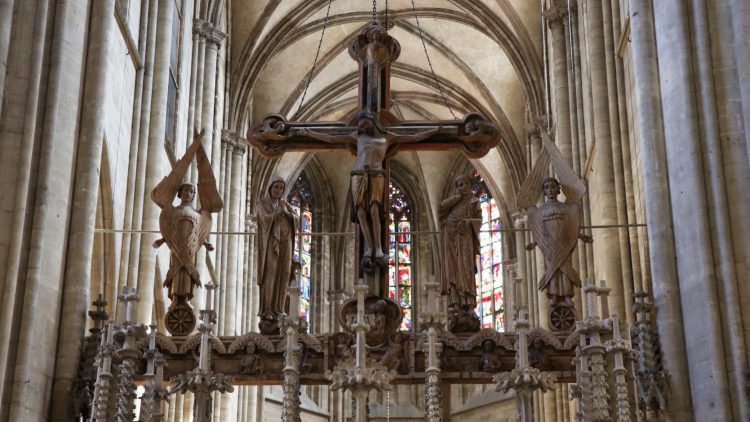
The Romanesque wooden triumphal crucifixion ensemble (Triumphkreuzgruppe) is often considered the most important work in the church. It dates from 1220 when the vaulting of the previous Romanesque nave was completely repaired following war damage in the battle between Henry the Lion and the emperor.
At the center, Christ on the Cross tramples on the devil while the cross itself is planted on the grave of Adam, who is rising from the death. Mary, mother of God, is standing on a snake to symbolize the triumph over sin, while John is standing on a pagan king (emperor Nero?). The cross measures 5.15 m by 3.5 m while the figures are 2.2 to 2.4 m tall.
On the sides are two angelic figures on wheels of fire indicating their roles as heavenly messengers. These figures have been debated much: from the main church the laity could only see four wings of the cherubim, while from the choir the six wings of a seraph may be seen. In medieval Christianity, a seraph was often considered the highest rank angel who enjoyed direct communication with God, while a cherub was the second-highest rank. (The association with putto and depictions as plump winged boys with angelic faces only came later in western art.)
These figures are mounted on an 8.5 m long, 75 cm thick oak beam decorated with figures of the apostles. Originally, there would have been 12 and the beam was 1.5 m longer. However, when taken from the old Romanesque church, the beam was cut to fit between the pillars of the crossing of the new Gothic basilica. Originally the figures would have been painted buttony a little of the medieval colors may still be seen today.
Sculptures in Halberstadt Cathedral
The church has many original medieval sculptures, although many were lost through the centuries and some plinths are empty. In the north transept are a naive Adam and Eve, God looking down from above the Paradise Tree with the snake (Tree of Knowledge). At the bottom is the coat of arms of the donor.
In the crossing, note St Jerome with the Lion (1480) and Charlemagne — he was revered in Halberstadt and often seen here as a saint, as was customary in Aachen but not universally accepted by the church. Below the sculpture of St George Slaying the Dragon is the date 1487 written in Gothic numbers.
The church has many further paintings, sculptures, and artworks from the medieval period. Some are copies with the originals on display as part of the treasury.
Choir and Ambulatory
In the high choir, the 64 seats of the oak stalls (around 1400) confirmed the importance of the cathedral chapter. The painted doors are late 19th-century copies of the originals (in the treasury). Further items include a Gothic painted wooden sacrament cabinet, bronze eagle lectern, and paintings but once again the best items are in the safekeeping of the treasury. Note when looking back at the angelic figures on the crucifixion group that the third set of wings may be seen from the choir only.
The winged altar is a late 15th-century triptych. Calvary is at the center, on the left-wing are scenes from the life of Mary, and on the right from the life of St George. The predella was taken from a different altar, the original with relics is preserved in the treasury.
The stained glass windows in the choir include 290 original medieval scenes. The oldest date from shortly after 1400 and are related to the magnificent stained-glass windows in the Dom zu Stendal.
The sarcophagi in the ambulatory are mostly medieval too, especially from the 15th century. Note the iron cage on the wall — this was to keep books safe.
The only chapel in the ambulatory is the Mary Chapel (Marienkapelle) with a 15th-century painted radiant Madonna altar. More unusual are the large sculptures from around 1360 depicting the adoration of the Magi. The painted Madonna and child sculpture is from the 13th century.
A second Mary Chapel is outside the church off the cloisters. This richly decorated Neustädter Kapelle, sponsored by Domprobst Balthasar von Neuenstadt, was completed in the early 16th century. The new chapter house (Neue Kapitelsaal) was completed around the same period in 1514.
The church is of course a Christian institution but when it comes to superstition, it is often better to be safe than sorry. Note the whalebone that should protect against floods (or water damage) and a flintstone protecting against fire.
Halberstadt Cathedral Treasury
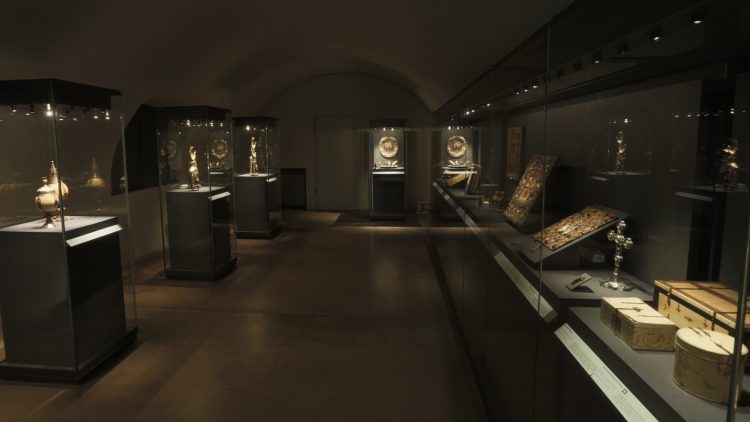
The cathedral treasury (Domschatz) of Halberstadt is one of the largest and most important medieval collections in Germany. It consists of around 650 items of which 300 are on permanent display.
Much of the treasury was donated in 1208 by Bishop Konrad von Krosigk, who returned laden with treasure from the fourth crusade — the one when as a particularly low point in the history of Christianity the Christian city of Constantinople was raided.
Some of the treasure was lost when the Hohenzollern Cardinal Albrecht von Brandenburg (1490-1545) moved part of it to his other projects in Mainz and Halle (Saale). Following the Reformation, many of the items were no longer in use but preserved as both Roman Catholic and Lutheran parishes used the same church and a special committee keep watch over the items.
The treasury is on display in various rooms off the cloisters, on the tribune inside the church, and in a modern wing. During a visit to the treasury, visitors also have the opportunity to see the Neustädter Kapelle, the cloisters with several rooms, and cross over the gallery of the south transept with a 14th-century Gothic bronze baptismal font painted with scenes from the childhood of Christ.
Domschatz of Halberstadt
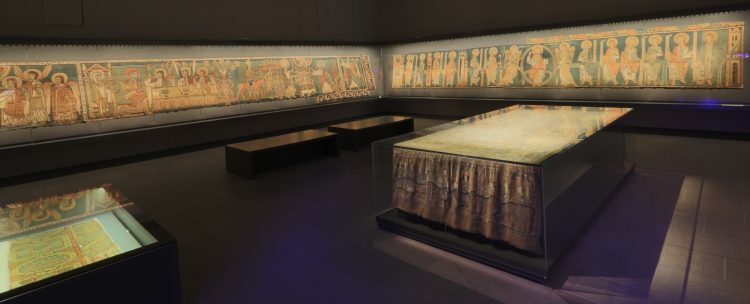
The Domschatz consists of the usual items found in cathedral treasuries but in larger numbers, better artistic quality, and in some cases of historical importance, such as altars, reliquaries, relics, paintings, statues, keystones, architectural detailing, vessels, religious paraphernalia, vestments, books, and tapestries.
Romanesque Tapestries in Halberstadt
The tapestries are of particular note and some of these Romanesque tapestries are amongst the oldest in Europe — the publicity department is keen on pointing that its equal is not even found in the Louvre.
The mid-12th century Abraham and angels tapestry is 10.26 m long while the Christ and the Apostles tapestry from the same period measures 9 by 1.32 m. Both are in remarkably good condition with the colors still vibrant. These are the oldest picture tapestries in Europe.
The Charlemagne tapestry is from 1230/40 while the early 16th century Mary tapestries made for the Neustädter Chapel consist of two pieces each 14 m long.
In a similarly good condition is the large collection of very well-preserved religious vestments including a magnificent Mitra from around 1300. The old wooden cupboards and original painted doors are also interesting to see.
Treasures in the Domschatz of Halberstadt
However, the bling — many items brought from Constantinople — never fails to impress. Some of the items include:
- A hand warmer with leather case (around 1300) — a warm stone was placed inside the beautifully decorated metal globe to allow a priest to warm his hands during a long service.
- A bronze aquamanile in the form of a lion (around 1200).
- A Byzantine gilded silver eucharist plate from the 11th century.
- Ostrich egg reliquaries from around 1230 and 1320.
- Various arm reliquaries — one from 1225 has an arm bone of St Nicholas.
- Many relics, including a splinter from the holy cross and a thorn from the crown.
- A relic of a stone thrown at St Stephen (from around 1210 — the relic, Stephen was the first Christian martyr and died around AD 36/40).
- Book covers with elaborate jewels, metalwork, and ivory reliefs.
- An ivory consular diptych from Ravenna dates from 416 making it the oldest item in the collection.
Visitors Information for the Dom and Domschatz in Halberstadt
Opening hours of the Dom and the Domschatz are:
Tuesday to Saturday from 10:00 to 16:00, Sunday and vacation days 11:00 to 16:00. Closing times are 17:00 from May to October.
Admission is €8. Free for children under 18.
Organ in the Dom zu Halberstadt
Halberstadt played an important role in the history of the pipe organ. In 1361, Nicholaus Faber installed a new organ with a 12-tone keyboard in Halberstadt Cathedral. This organ was probably the first instrument of this kind using the claviature of 12 notes still used today by all regular pipe organs.
The current cathedral organ is a modern work by Eule Orgelbau (1965 & 1985) with 5284 pipes 66 stops played on four keyboards and pedals. It is installed in the baroque case (Orgelprospet) from 1718. This organ is usually played in concerts on Saturdays at 18:00 from May to October. It may also be heard from Easter until end-October most Saturdays at noon (free) and during the service at noon on Friday.
The role of Halberstadt in the first documented modern organ in the world made the city the logical choice for the installation of the John Cage ORGAN²/ASLSP As Slow As Possible concert. This piece played on a special organ will take 639 years to complete. Parts of it may be heard for free in the St Burchardi Church — it is well worth the short walk from the center as some of the streets (notably Bakenstraße and Rosenwinkel) have original half-timbered buildings that survived the inferno of 1945.
See also Raymond Faure’s site with many photos of the Dom (and many other sights on the Romanesque route of Saxony-Anhalt. Amazon (Germany) has a large selection of books on the treasury while only a few of the objects are described on the official website.
